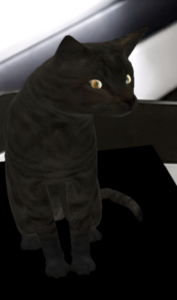November 1, 2021
- The tree, critter, and sky are things you see with your eyes. So, they are concrete. The tree, critter, and sky are also part of the world of natural resources. This is a picture of a beautiful critter in a park near my condo. This image can also be used to teach about the “psychological benefits/needs” public parks bestow upon society. “Psychological benefits/needs” is the economic idea that human beings naturally desire or want to buy, sell, or engage in activity for solely non-monetary considerations. We do it because makes us FEEL GOOD! The small animal photographed provides a concrete way to see how the abstract idea of “psychological benefits/needs.”
- On the abstract level, this photo of a cat generated by a 3D Merge Cube experience is an abstract way to think about economies. This 3D artistic expression may be used to teach critical thinking. Suppose the image of the black cat was put on a PowerPoint slide with the following question: How does this 3D cat express the elevation of human creatively through technology? This asks students to delve deeply into creative thought to answer this question.
Images provide a way for students to engage in abstract thinking in new ways. This creative teaching is limitless in its application. Let students elevate themselves to the realm of abstract thought by designing their own ways of expressing skill in abstract thought through image curation and creation.
Images are windows into our physical and mental world. Imagine what could happen if we let images transform economics!
Images Add Creative Space
I. Use personal pictures. (That’s me and that’s Manhattan!) Students love pictures and pictures can be used to tell a story! You can relate economics to your story. I use my trip to New York to teach the cost/benefit of the skyscraper {why it is cheaper to build up!}, the economies of travel industry, and the social/emotion value of personal enjoyment. I use power-point slides tell my stories. Students have stories to tell too! Their power-point presentations have limitless ways to relate economics to personal pictures.
II. Teach students to think concretely and abstractly about economics using images. Mastery of economics calls on learners to apply and analyze econ concepts and ideas using concrete and abstract thinking. It is thus important for students to develop these skills. You Tube provides good educational videos of these two levels of thinking. To save you time, here’s one! Before delving deep to econ, it would of high value to prime the students’ minds with direct instruction on the concrete and abstract. Use images in your teaching.
Here are two examples:
- The tree, critter, and sky are things you see with your eyes. So, they are concrete. The tree, critter, and sky are also part of the world of natural resources. This is a picture of a beautiful critter in a park near my condo. This image can also be used to teach about the “psychological benefits/needs” public parks bestow upon society. “Psychological benefits/needs” is the economic idea that human beings naturally desire or want to buy, sell, or engage in activity for solely non-monetary considerations. We do it because makes us FEEL GOOD! The small animal photographed provides a concrete way to see how the abstract idea of “psychological benefits/needs.”
- On the abstract level, this photo of a cat generated by a 3D Merge Cube experience is an abstract way to think about economies. This 3D artistic expression may be used to teach critical thinking. Suppose the image of the black cat was put on a PowerPoint slide with the following question: How does this 3D cat express the elevation of human creatively through technology? This asks students to delve deeply into creative thought to answer this question.
Images provide a way for students to engage in abstract thinking in new ways. This creative teaching is limitless in its application. Let students elevate themselves to the realm of abstract thought by designing their own ways of expressing skill in abstract thought through image curation and creation.




